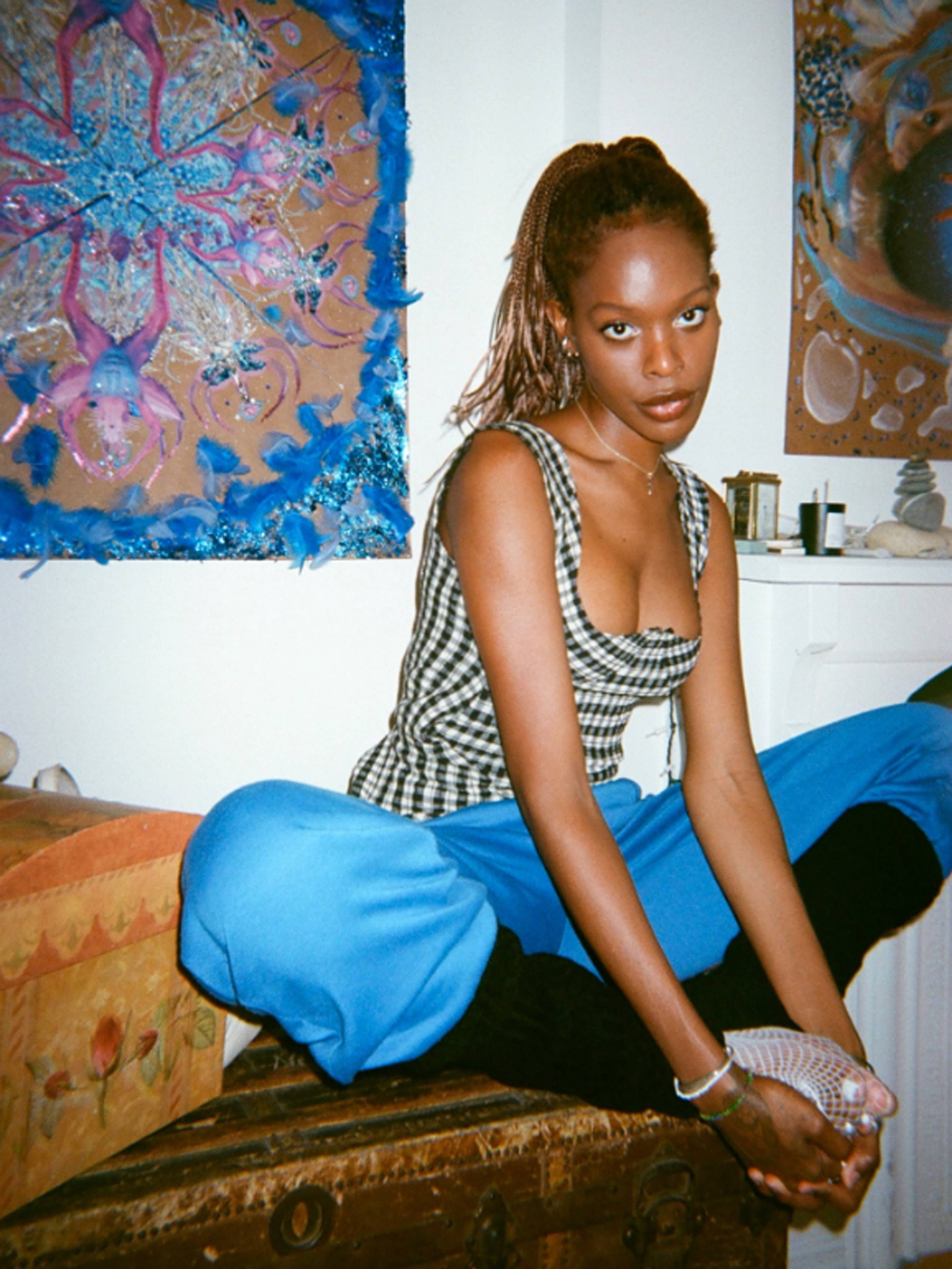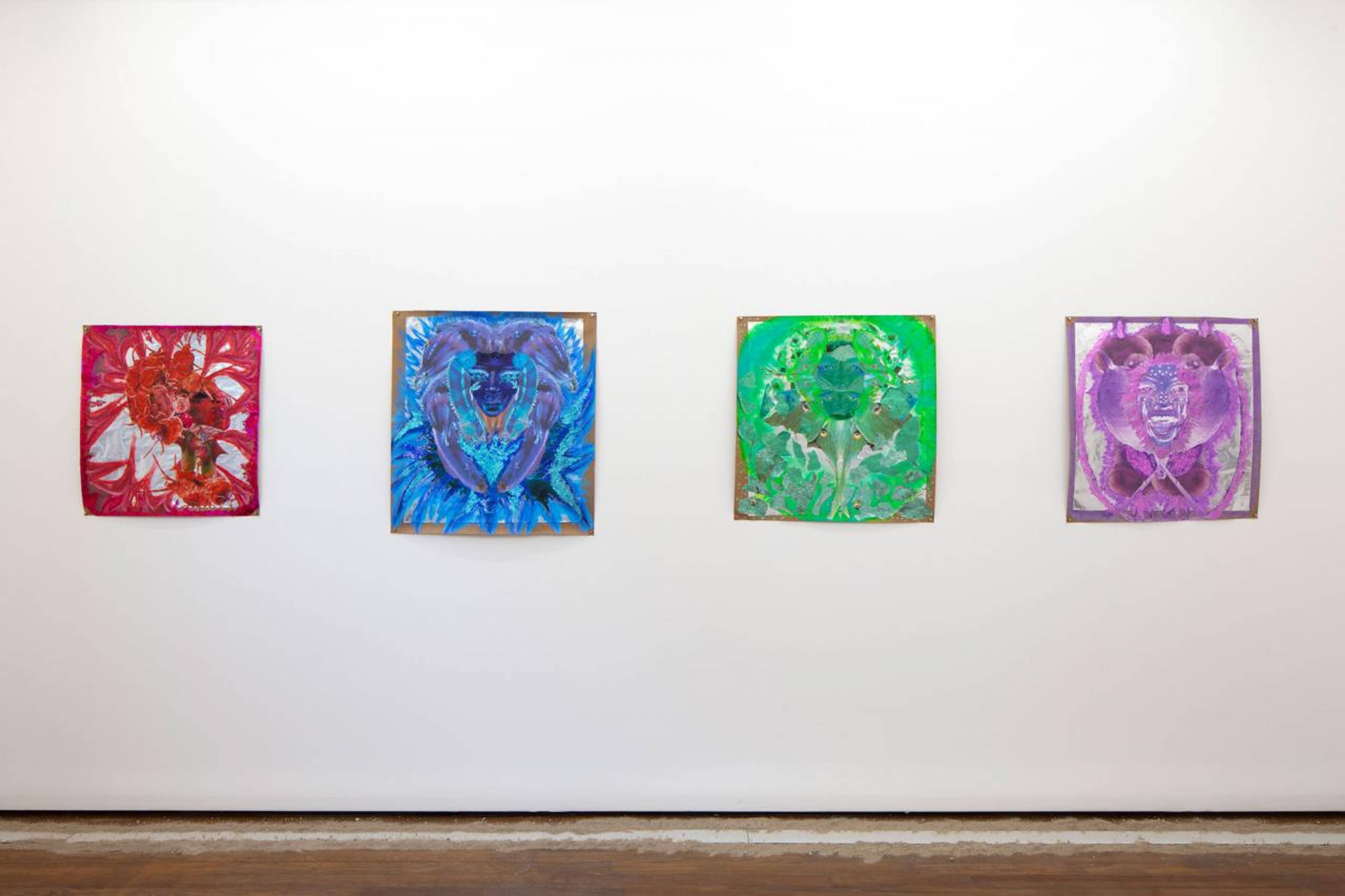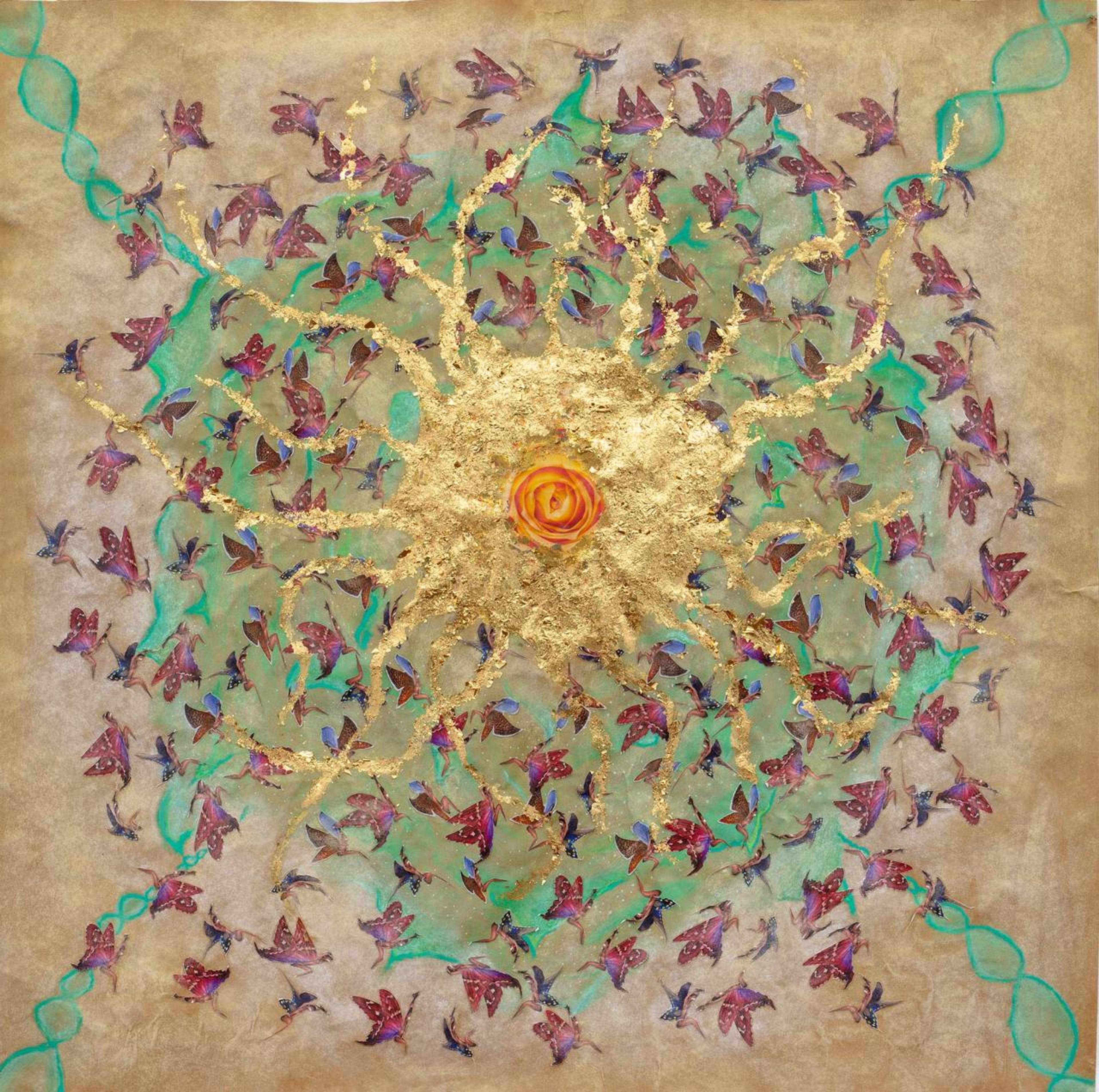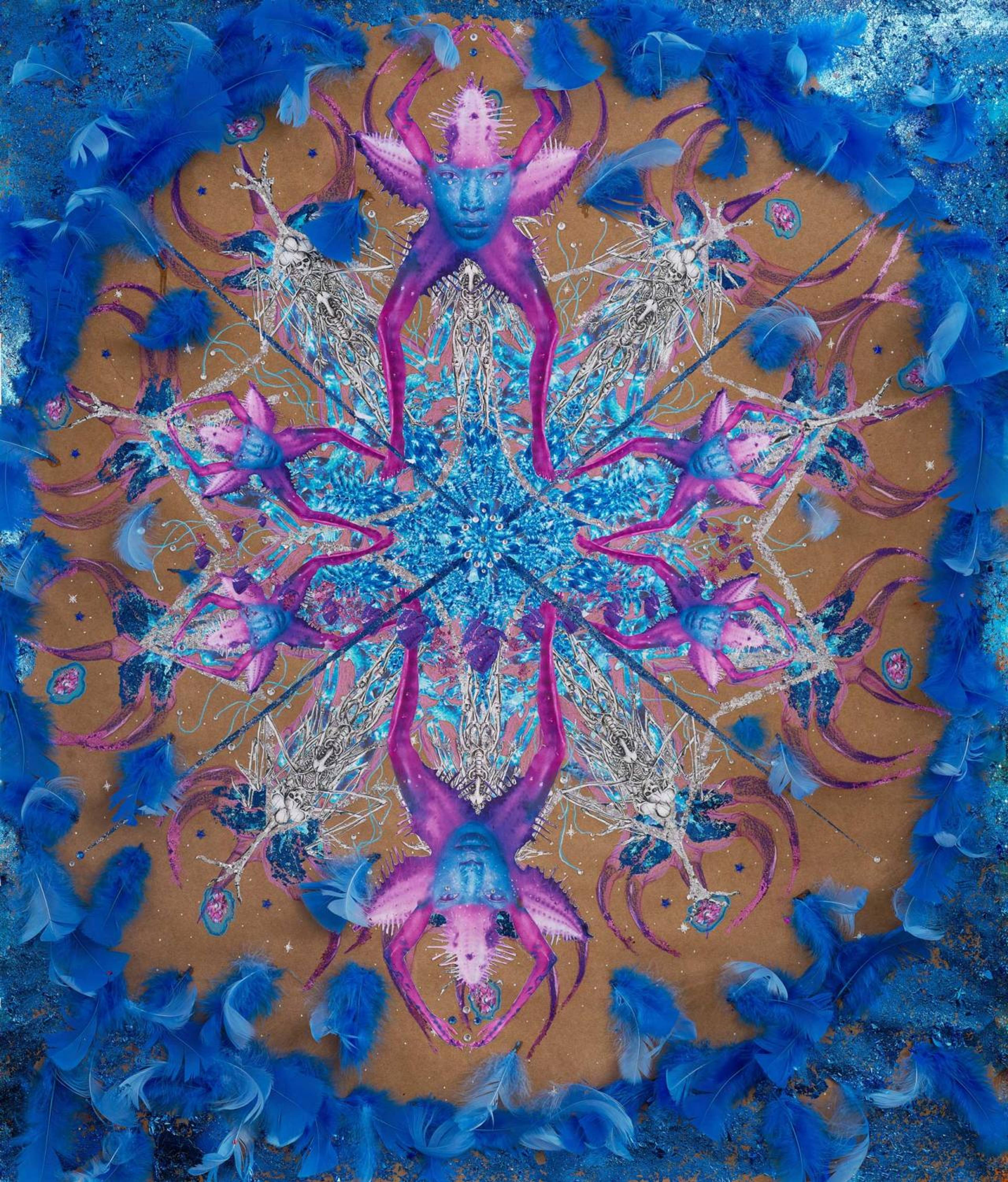Slant Rhyme: Where did you grow up, and how has that upbringing influenced your work?
Aurel Haize Odogbo: I’m Nigerian-American, born and raised in Baltimore, where a lot of my family still lives. I'm not sure if my upbringing has influenced my work in terms of where I was raised or how much my family relates to spirituality, fantasy, and science fiction, so much as pulled me by my curiosity. Being Nigerian definitely influences a lot of the work, in that there is a common theme of ancestor veneration in literal but also more abstract ways. When I think about the source of my interest in reimagining the figures in various forms of Western religious iconography, I think about my father being really Christian, but also being an Edo man from Benin City, where I know Christianity wasn’t the primary spiritual practice until the 15th century and none of the placeholders for God looked like us. That’s a contradiction I’ve been curious about since I was a teen. Whereas my mother’s side of the family isn’t as religious or spiritual in any way.
The works are influenced by figures and ideologies in Greek mythology, Christianity, The Orishas of Ifa, esotericism, and chaos magick. Each of them is like a portal into its own nirvana, something proximate to a heaven, but also where a sense of placeless-ness lingers, too.
Aurel Haize Odogbo, Apathetic Heat at the Nucleus of My Aortic Beckoning: Obiii, The Power of Empathy (FlutterPulse), 2022, metal leaf, soft pastel, hard pastel, color pencil, grated pastel pigment, acrylic paint, and collaged sourced paper images on brown kraft paper, 185.5 x 122 cm
SR: Are you thinking about traditions based in Black folklore – such as pre-colonial oral histories and sharing proverbs or “moral lessons?”
AHO: I feel that people have a raw and pure faith connected to these ideologies and practices that are not necessarily colonial-Christian or Catholic in nature – there’s something underneath. I am fascinated with the endless possibilities that people of the African diaspora enjoy when they reconfigure and restructure these faith systems for themselves. I often think about the Black people who grew up Catholic or Baptist, attending church – this lineage of people who poured their energy into faith, and how powerful that same kind of faith can potentially be if centered in something less dogmatic, a form of faith that inspires questions like: What does my god, my angel, or my placeholder for purity look like? Is this faith baked in fear? How does this entity make me feel? Are they grotesque? Are they repulsive?
I think it’s beautiful when these belief systems can become something akin to ancestor worship because, for me, it amounts to believing in yourself, even on an epigenetic level, as a culmination of your ancestors. This theme shows up in the work in a slightly more abstracted way in my love for stars, which, as the origin points of all the elements on which the organic compounds that make us human are based, are our most common collective ancestors. I like to communicate this sort of macro-to-micro relationships – here between stars and my specific Nigerian ancestry – around the lineage in my work.
View of Aurel Haize Odogbo, “Quasiii – PortalsUponPortals,” Deli Gallery, Mexico City, 2023
SR: Can you speak to what you were thinking about while you worked on Aetherflies Enthralled in AuTauris Swan Song (2020), which you called the origin point of this body of work?
AHO: I was thinking a lot about desire, libidinal energy, and what is possible when I redirect and harness the capacity to feel and touch into a declaration/devotion to myself, as something that drives me, pushes me, pulls me. Beyond the theme of redirected desire, I was imagining a supernova, which, though it’s the death of a star, could be seen as a celebratory event, instead of one centered in sadness. The work honors this heavenly body, with Aetherflies swarming in and around its bioluminescent vapor – shrieking, crying, and shedding tears of joy at this event, redirecting mourning into an intense, collective bliss. The gold represents this Aether, or a fifth element, released at the onset of (star)death. It produces a kind of gravitational pull that the Aetherflies can’t resist.
It always felt far-fetched to me to think that I could give life to my own characters, make narratives for those characters, and build worlds for them to live and thrive in.
SR: There are autobiographical elements to your work, though no conventional self-portraits. How do you think about visibility and invisibility when you’re building new worlds?
AHO: When I’m making work, I often think about being young and finding sci-fi and fantasy magazines or comics like Heavy Metal Magazine, Vanguard illustrated, and Epic Illustrated, as well as the works of Boris Vallejo and his various successors, and being really excited about seeing characters that resembled myself and always wanting to see more of it – I guess to feel and know that unambiguously Black people, especially Black women, navigate these beautiful, fantastical other-worlds, but most of all, that they had their own narratives that I could learn about.
It always felt far-fetched to me to think that I could give life to my own characters, make narratives for those characters, and build worlds for them to live and thrive in. Not that I’m the first to do this for Black women curating fantasy, of course – I have my predecessors! I think it’s important to write and illustrate narratives iteratively, because there’s always going to be another, younger version of myself who didn’t see herself reflected in the art she felt most drawn to.
Aurel Haize Odogbo, Aetherflies Enthralled in AuTauris Swan Song, 2020, metal leaf, soft pastel, hard pastel, color pencil, grated pastel pigment and
collaged sourced paper images on brown kraft paper, 91.5 91.5 cm
SR: Can you tell me about Altaria?
AHO: Altairia is one of two protagonists in a short story that I wrote called “StarSeedToStarDustToStarFlesh” – I named her after Altair, a star that is part of an astrological formation called “The Summer Triangle,” which also includes Vega, the fourth brightest star in our sky.
In my story, Altairia is a young Black woman living in New York in the 1960s. She is homeless and is navigating what she’s always understood to be a form of schizophrenia, but she has always sensed that her psychological state was beyond diagnosis. She has these sporadic, hyperreal hallucinations of being torn across space and time to the creation of some of the first stars. She’s blinded by their brightness, but not afraid of them – rather, there is a sense of comfort she feels. Altairia also often has her consciousness transported to New York in 2019, where she is able to share the perspective of a young woman around her age and who is her descendant – not via blood, but via shared experience or lifepath. Vega’s abilities are centered around a hyper-analytic mind and extremely heightened senses: She can peer through skin to the layers of the dermis, muscles, and bones of her peers, taste the iron in sweat, see the aura and heat clinging to and coming off of a body, and distinguish the hertz in an octave of a scream.
SR: What can viewers expect from your solo show
AHO: There are fourteen works in the show made in the span of one year, plus Aetherflies , which is from 2020. There will also be a takeaway catalogue that contains all of my writing that corresponds to some of the visual works in the show, so I’m glad that people will also get to experience that element of my practice.
I try to imbue intensity, intention, and emotion in everything that I do, so I hope that viewers can feel it and be pulled in by it – that the show can be a sort of invitation into one or all of the worlds that I am building.
Aurel Haize Odogbo, (StarSeedToStarDustToStarFlesh) “I’m Not The Serpent — I’m The Eagle Cutting Down Clutching With Dead Aim, Talons On The Frame” Vega, 2022, metal leaf, soft pastel, hard pastel, color pencil, grated pastel pigment, baby blue and cobalt blue feathers, 3D star stickers, and collaged sourced paper images on brown kraft paper, 91.5 x 76 cm
___
“Quasiii—PortalsUponPortals”
Deli Gallery, Mexico City
20 May – 8 Jul 2023






